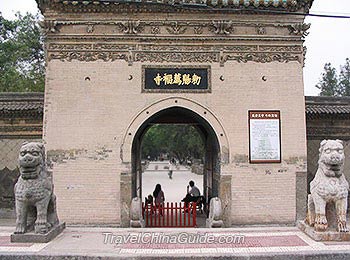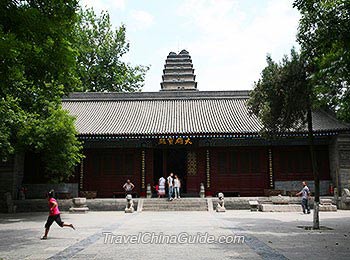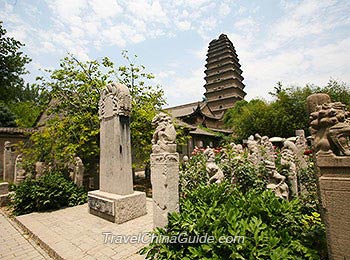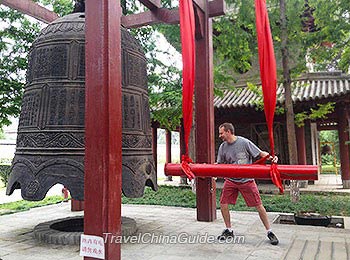Jianfu Temple
Located in the northwest corner of Xi'an Museum on West Youyi Road in south Xi'an, Jianfu Temple is a famous Buddhist temple with a long history. Symbolic of the temple is the Small Wild Goose Pagoda which was listed as a world cultural heritage site by UNESCO in 2014.
History of Over 1,000 Years
In the second year (706) of the Shenlong Period under the reign of Emperor Zhongzong in the Tang Dynasty, the temple was transformed into a Translation Institute of Buddhist Scriptures. It attracted numerous eminent monks both from home and abroad to translate here.
Among all the monks, Yi Jing was the most distinguished. He was as famous as Xuanzang who presided over the translation of Buddhist scriptures in the Da Ci'en Temple. Yi Jing translated 108 volumes from 706 to 713, making the Jianfu Temple one of the three biggest translation institutes of Buddhist scriptures in China.
Major Buildings of Jianfu Temple
|
|
Built in the late Qing Dynasty (1644-1911), the gate has a length of 2.9 meters (9.5 feet) and a width of 2.55 meters (8.4 feet). It has a single eave embellished by blue glazed tiles. Moreover, it is decorated by beautiful brick carvings under the eave. On the south of the gate hangs a plaque inscribed with “Imperial Jianfu Temple” while on the north is a plaque engraved with “the True Way”.
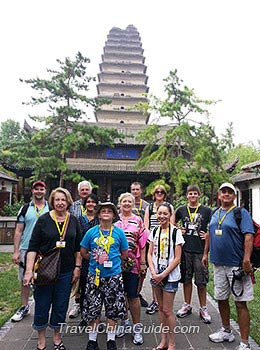 |
| Our Tour Group in Jianfu Temple |
The Cishi Pavilion was first constructed in the Ming Dynasty (1368-1644). It is a double-eave terrace, 16.4 meters (53.8 feet) in length and 8.2 meters (26.9 feet) in width. Between the two eaves hangs a wooden board with the inscription “Imperial Jianfu Temple”. There are brick stairs on the two sides.
Built in the Qing Dynasty, the Mahavira Hall has a single eave. It has five rooms in the front. It measures 21.2 meters (69.6 feet) in length and 13.3 meters (43.6 feet) in width. The supporting pillars are 3.8 meters (12.5 feet) high, with a diameter of 0.23 meter (0.75 foot).
The Depository of Buddhist Sutras is a two-floor double-eave building, with five bays in length and three bays in width.
The Small Wild Goose Pagoda is a multi-eave Buddhist pagoda surviving from the Tang Dynasty (618-907). It measures 43.4 meters (142.4 feet) in height. Because both the height and side length of each storey decrease progressively, the pagoda looks like a rectangular pyramid. Inside the pagoda, a narrow stairway winds to the top.
|
|
Morning Bell of the Small Wild Goose Pagoda
One day during the reign of Emperor Kangxi (1662-1723) in the Qing Dynasty, a woman heard the bang of metal when she was washing clothes by the Weihe River. Immediately she reported it to the local government. After excavation, the bell which was lost for more than four hundred years was discovered again and it was given to the Jianfu Temple.
In the Qing Dynasty, monks in the temple clanged the bell every morning to pray for happiness and to express their good feelings.
In 1998, a copy of the bell was made. Tourists can toll it on the steel frame in the open. The original bell is displayed in the Bell Tower.
Ancient Trees
Traditional Temple Fair
How to Get to Jianfu Temple
1. Take bus No. 18, 21, 29, 32, 40, 46, 203, 204, 218, 224, 229, 258, 407, 410, 508, 521, 618, 700, 707, 713, Tourist Line 7 or Tourist Line 8 (610), get off at Xiaoyanta (Small Wild Goose Pagoda) Station and get to the temple through North Gate.
2. Take bus No. 18, 203, 204, 218, 229, 258, 407, 410, 713 or Tourist Line 7 and get off at the Xiajiazhuang Station. Walk north for around 4 minutes and get to the temple through West Gate near the Xi'an Museum.
Take Metro Line 2, get off at Nanshaomen Station, and leave from Exit A1 or A2. Walk west for about 6 minutes and get to Jianfu Temple through North Gate.
Xi'an Bus/ Metro Search
| Ticket Price | The temple: Free of charge on ordinary days; CNY 20 to 25 during the temple fair from 1st to 15th of the first lunar month. Ascending the Small Wild Goose Pagoda: CNY 30 |
| Opening Hours | March 15-October 31: 09:00-18:00 (Ticket selling stops at 17:00) November 1-March 14: 09:00-17:30 (Ticket selling stops at 16:30) Close: Every Tuesday (except Chinese national holidays) * During the temple fair, the temple allows entry until 21:00 and is emptied at 22:00, while the Small Wild Goose Pagoda closes at 16:30 as usual. |
